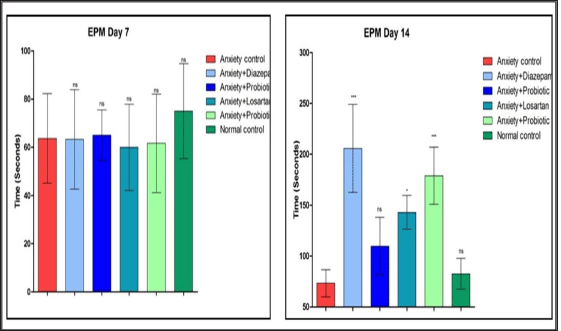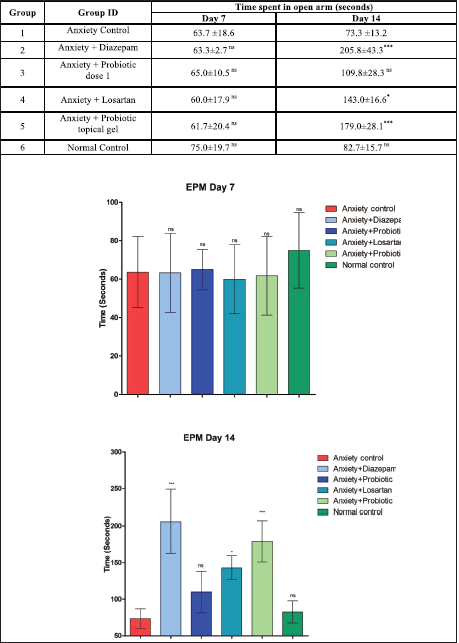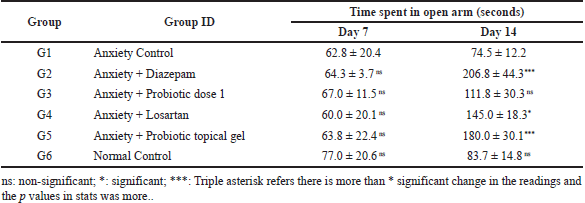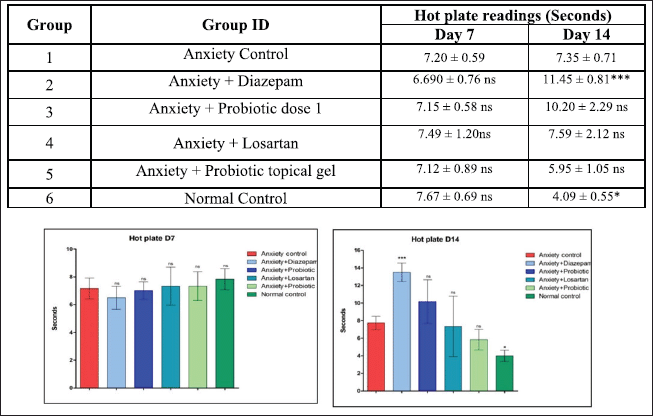INTRODUCTION
Anxiety is a mental state that is accompanied by a real or imagined threat in the future. Anxiety symptoms include nervousness, tension, fears, insomnia, depression, general somatic symptoms such as muscle pain, hot or cold flashes, and blurred vision, cardiovascular symptoms such as tachycardia and palpitations, gastrointestinal symptoms such as nausea and vomiting, and genito-urinary symptoms such as the urgency of micturition, and amenorrhea (Hamilton, 1959). According to current National Institute of Mental Health data, 18.1% of individuals in the United States have suffered from anxiety-related disorders, with 22.8 0% of instances were found to be very severe. The average age of start of anxiety is 11 years old, and women are 60% more likely than males to be affected (Schäfer et al., 2017).
Beverage consumption has grown dramatically in foodstuff. Caffeine may be found in a variety of forms, including coffee, green tea, coffee beans, and coffee cakes. Green tea capsules, green coffee beans, and cocoa are among the items being developed by pharmaceutical and nutraceutical businesses (Cichello et al., 2014). Caffeine stimulates the sympathetic nervous system, which stimulates noradrenergic neurons and controls dopamine release. Caffeine stimulates noradrenergic neurons and influences dopamine release locally (Hamilton, 1959). There has been a massive increase in coffee shops and cafes as a result of which the majority of the population is suffering from undiagnosed anxiety problems (Schäfer et al., 2017). Caffeine is the most widely used stimulant in the world which has an anxiogenic effect. Coffee shops and cafes are springing up in practically every demographic zone, including hospitals, causing the majority of people to suffer from undiagnosed anxiety problems (Jahrami et al., 2020). Anxiety symptoms differ from person to person depending on their sensitivity to the methylxanthine component found in coffee. Because of the hazards involved with synthetic anti-anxiety medicines, natural alternatives that are free of side effects are recommended (Dahanukar et al., 2000).
Probiotics are live bacteria that attempt to improve health by preserving and repairing gut flora. The increasing role of probiotics in medical science is a novel area of study. Recent research reveals that gut microorganisms alter physiological aspects of the body and contribute to inflammation and mental illnesses (Puebla and Reid, 2019). Several investigations have shown that gut microorganisms communicate with the central nervous system via the gut–brain axis. The disease is complicated by a lack of sufficient awareness of symptoms, diagnostic tools, and perceived need for therapy. To cover research gaps, this study will investigate the effect of probiotics and prebiotics, in addition to known treatments, on anxiety disorders in mice (Gisby and Bryant, 2000; Takada et al., 2016). A wide range of pharmaceutical dosage forms can be used in the topical drug delivery system. Gels, creams, and ointments are the most commonly utilized, followed by sprays and liquid solutions (Shinde et al., 2012). By increasing the resident time at the injection site, topical delivery with gels can enhance the resistance time of the drug on the skin and improve the delivery and release of the material. Considering all these potential advantages of the current scenario, we have undertaken the development of a probiotic-loaded gelling system for better treatment of caffeine-induced anxiety.
MATERIALS AND METHODS
Materials
Caffeine, Diazepam, Losartan, and Probiotic were purchased from Sigma Aldrich. Probiotic strain (Lactobacillus helveticus Strain NS8) was purchased from SFCL India. Carbopol 980 was purchased from Lubrizol India. Triethanolamine (TEA), and Glycerin were purchased from Loba Chemie, India. Methyl paraben and propyl paraben were purchased from Sigma Aldrich India. All other chemicals were of analytical grades used in the study.
Methods
Formulation of probiotic-loaded gel
The gel was developed by a cold method using Carbopol 980 polymer (Bansal et al., 2009). Probiotic strain (L. helveticus Strain NS8) was dissolved in a sufficient quantity of double distilled water and to this solution Carbopol, 980 (0.6% to 1% w/w) was dispersed under continuous stirring. Methyl paraben (0.1% w/w) and propyl paraben (1.0% w/w) were added to polymeric dispersion under continuous stirring. Glycerin (0.5% to 3% w/w) was added to the polymeric phase. The resulting dispersion was kept for complete hydration at 2°C–8°C for 24 hours in the refrigerator. The polymeric gel was neutralized with dropwise addition of TEA and the final pH was adjusted to 5–5.5. The formula composition is presented in Table 1.
Characterization of gel formulation
Physical appearance and clarity
Visual inspection against a black and white background was used to determine the clarity and appearance of developed gel formulations.
pH of the gel
The pH of the gel was evaluated using a calibrated pH meter. Each measurement was made in triplicate, and the average of these results was used to calculate the pH of the gel.
Spreadability of the gel
The spreadability of the developed gel was determined by spreading 0.5 g of the gel over a premarked circle of 2 cm diameter on a glass plate, followed by the use of a second glass plate. For 5 minutes, a half-kilogram weight was allowed to lie on the upper glass plate. The diameter was measured after the gel was dispersed (Imam and Sumi, 2000).
Centrifugation test
In a tapered test tube, 5 g of the formulation was placed to perform the centrifugation test. The sample gel was centrifuged for 20 minutes at room temperature using 5,000 rpm using Remi Medico Centrifuge C-852.
Viscosity of the gel
A Viscometer (Brookfield Viscometer-RVDV-E) was used to measure the viscosity of the developed gel formulations. The gel was rotated 10 times per minute at 10, 20, 30, 40, 50, and 60 times per minute. The equivalent dial reading was taken at each speed.
Stability studies
The gels were filled in collapsible tubes and accelerated stability studies were conducted as per ICH guidelines (ICH Q1AR2). The tubes were placed at 20°C–25°C and 40°C ± 2°C for a period of 12 days and evaluated for clarity, pH, and consistency, and stability of the formulation was predicted.
Anti-anxiety study in an animal model
Wistar male rats weighing 180–220 g (6–8 weeks old) were used in this study. All animal handling experiments were done as per CPCSEA guidelines with prior approval of the Institutional Animals Ethics Committee (approval number: IAEC SSCP No: 171/2020-21). The animals were subjected to laboratory conditions for a minimum of 7 days. The animals were kept in a conventional laboratory setting. The animals were fed typical laboratory rodents and were given free access to reverse osmosis drinking water. The experiment was carried out in six groups of six rats each (n = 36). Caffeine and diazepam were dissolved in 0.9% normal saline. The probiotic was prepared in sterile water and dosed according to the experimental design. Caffeine was given intraperitoneally at a rate of 25 mg/kg every day for 14 days (Bhattacharya et al., 1997). On the eighth day, before treatment began, all groups of animals were weighed, and Group-6 animals were given vehicle (normal saline). Caffeine was administered intraperitoneally to G1-G5 rats at a dose of 25 mg/kg. For groups 3 and 4, the probiotic formulation was administered orally following the caffeine dose. In group 5, a probiotic topical gel (30 mg) was given topically to the animals’ foreheads. Diazepam (1 mg/kg) was administered to the animals in Group 2. The grouping of animals is presented in Table 2.
 | Table 1. Formula composition of probiotic-loaded gel. [Click here to view] |
 | Table 2. Grouping of the animals and treatment details. [Click here to view] |
Eddy’s hot plate method (pain test)
The animals’ baseline reaction time was assessed by exposing them to a hot plate that was held at a constant temperature of 55°C. Leaping or paw licking-like reactions were observed and documented. A 15-second cut was planned to avoid inflicting harm to the paws. This test was performed both before (on Day 7) and after the therapy (Day 14) (Sudakov et al., 2013).
Elevated plus maze (EPM) test
Rats were examined in an EPM on Days 7 and 14. For all of the tests, the light phase of the light/dark cycle was employed. Each session lasted 5 minutes and was held with the lights on. Each test began with the rat facing the junction of the maze. The EPM was cleaned immediately after each test to avoid the introduction of pheromonal signals. To manually record exploratory behavior on the maze, a timer was utilized. Basic motions, open arm entries, and open/closed arm duration were the dependent metrics (Cook and Brown, 2018).
Blood serum serotonin level
An aliquot of 1.25 ml of blood was taken from test animals and placed in anticoagulant-free tubes before being centrifuged at 3,500 rpm for 10 minutes at 5°C. The serum aliquots were frozen and kept at −80°C until the day of the analysis. The ELISA Serotonin kit was used to test the serotonin. Serum serotonin levels in the normal range should be 50–200 ng/ml.
Statistical analysis
In each group, EPM and Eddy’s hot plate readings were estimated, and SD was calculated. At 95% confidence levels, significant differences between group mean and control were assessed using one-way analysis of variances, followed by a Dunnett’s multiple comparison test in Graphpad Prism. A p-value of 0.05 was deemed significant.
RESULTS AND DISCUSSION
This research work deals with the development of novel topical probiotic-loaded gel for the efficient treatment of caffeine-induced anxiety. The developed gel formulation was physicochemically characterized. The anti-anxiety potential of the developed gel was compared with the standard drug Diazepam in an animal model. This study was performed for 14 days, and Eddy’s hot plate, EPM, and serotonin levels were assessed over the study period. Probiotics were found to lower anxiety levels in people with anxiety in one of the studies. These findings are critical in the treatment of anxiety. More appropriately powered random clinical trials (RCTs) with standardized metrics will be needed in the future to determine which probiotics and doses, as well as treatment periods, are most useful for anxiety (Huang et al., 2017). The zebrafish model’s swimming style is altered after extended intake of Lactobacillus rhamnosus CECT8361 and Bifidobacterium longum CECT7347. Adult zebrafish given this probiotic combination of probiotic microorganisms had less bottom-dwelling geotactic behavior, according to the findings. A lower level of anxiety is linked to this fundamental behavioral reaction. As a result, ingesting this probiotic cocktail might be regarded as an useful therapy for anxiety episodes (Valcarce et al., 2020).
Physicochemical properties of the gel
The developed gelling system was evaluated for various macroscopic parameters which are presented in Table 3. The developed gel formulations were found to be slightly hazy to transparent in nature. The haziness might be due to the lower concentration of Carbopol 980 and Glycerin. The F5 formulation having higher Carbopol and glycerin concentrations has shown smooth texture while other formulations were found to be rough (F1-F4). The gels were also found to be clear in nature at higher concentrations. The higher concentration of glycerin might have imparted excellent clarity as well as texture to the gelling system due to its humectant property. The pH (5.0–5.5) of all gels was found to be compatible with the skin without making irritation. The viscosity of the formulations was found to be dependent on the Carbopol 980 concentration. The gels with lower polymeric concentrations had shown slightly fluidic characteristics due to lower viscosity. The F5 formulation had shown excellent viscosity (1050 CP) which makes it an easy application to the skin. The F5 formulation showed very excellent spreadability (1.8 ± 0.5 cm diameter) in comparison to other formulations which is quite an essential factor for topical drug delivery system. The spreadability of F5 was deemed high due to its minimal spreading time. The effectiveness of gels is dependent on how they are applied because gel spreading aids in the uniform administration of the gel to the skin (Gupta and Gupta, 2017) manufactured gels must be spreadable and meet the optimum quality in topical application. Furthermore, this is seen as a significant element in patient adherence to drug delivery techniques (Nordquist and Oreland, 2010). Through centrifugation study, it was found that the F5 formulation was visually stable in comparison to other formulations.
Eddy’s hot plate study
In all groups, the effect was found to be nonsignificant in comparison to the anxiety control group on Day 7. The latency time that is, time spent on the hotplate was significantly increased in comparison to the anxiety control group on Day 14. The animals treated with developed topical gel (Group 5) stayed on the plate for a longer period as shown in Table 4 and Figure 1. This observation demonstrated the effectiveness of the topical formulation in caffein-induced anxiety. On the other hand, the anxiety control rats (Group 1) stayed a very shorter period (7.35 seconds) on the hot plate in comparison to other groups. Higher anxiety levels are associated with a lower perceived pain threshold and more intense pain sensations, which explain why they only lasted a few minutes.
EPM test
Animals received diazepam (1 mg/kg) showed a significant increase time spent on open arms when compared with anxiety control (p < 0.01), probiotic high dose and probiotic topic gel treated animals (Group 5) also showed a significant increase in time spent in open arms when compared to the anxiety control group (Fig. 2). Whereas the probiotic low-dose group was non-significant when compared to the anxiety control group. The group 5 animals showed an increase in time spent as well as entries in the open arm suggested a decrease in the anxiety developed in the animals. This observation demonstrated the effectiveness of the topical probiotic gel in anxiety treatment. One of the studies showed that the EPM, probiotic supplements reduced open-arm exploration, indicating a reduction in risk-taking behavior. There were no differences in cognition, locomotion, or depressive-like behavior after the intervention. Furthermore, after the Dexamethasone Suppression Test, all intervention groups exhibited equal plasma corticosterone concentrations (Tillmann and Wegener, 2019).
 | Table 3. Physicochemical properties of the gel. [Click here to view] |
 | Table 4. Eddy’s hot plate study results on Day 7 and Day 14. [Click here to view] |
 | Figure 1. Eddy’s hot plate study results on Day 7 and Day 14. [Click here to view] |
 | Figure 2. Comparative time spent in open arm (seconds). [Click here to view] |
 | Table 5. Comparative time spent in open arm (seconds). [Click here to view] |
 | Figure 3. Comparative time spent in open arm (seconds) on 7th and 14th day. [Click here to view] |
 | Table 6. Serotonin levels in animal groups. [Click here to view] |
Serotonin levels in blood serum
The treatment groups have shown a lower amount of serotonin as compared to the anxiety control group. The animals treated with developed probiotic gel have also shown significantly lower concentrations of serotonin levels (Tables 5 and 6 and Fig. 3). Serotonin levels are one of the important factors in the control of anxiety because it is associated with the regulation of mood as well as behavioral changes (Jenkins et al., 2016; Nordquist and Oreland, 2010). So to control anxiety the levels of the blood serum serotonin are much to be controlled. The formulated gel excellently showed lower levels of serotonin.
Stability studies
The stability studies conducted on optimized formulation (F5) showed no significant changes in clarity, pH, and consistency in comparison to initial results. The gel formulation after 12 days of the stability study showed clear and transparent with pH 5.2 and stable inconsistency. These observations demonstrated that the developed probiotic-loaded gel formulation was robust and stable in nature and can be stored at room temperature. No additional storage condition is required for this formulation.
CONCLUSION
The study confirms the successful development of probiotic-loaded gel for the efficient control of caffeine-induced anxiety. The gel formulation showed a comparable reduction in anxiety to the Diazepam-treated animals and can be potentially used for the treatment of mild to moderate anxiety.
ACKNOWLEDGMENTS
All authors are grateful to GD Goenka University for support in smooth research.
AUTHOR CONTRIBUTIONS
All authors made substantial contributions to conception and design, acquisition of data, or analysis and interpretation of data; took part in drafting the article or revising it critically for important intellectual content; agreed to submit to the current journal; gave final approval of the version to be published; and agree to be accountable for all aspects of the work. All the authors are eligible to be an author as per the international committee of medical journal editors (ICMJE) requirements/guidelines.
FUNDING
There is no funding to report.
CONFLICTS OF INTEREST
The authors do not report any conflict of interest concerning to this research work.
ETHICAL APPROVALS
All animal handling experiments were done as per CPCSEA guidelines with prior approval of the Institutional Animals Ethics Committee (approval number: IAEC SSCP No: 171/2020-21).
DATA AVAILABILITY
All data generated and analyzed are included in this research article.
PUBLISHER’S NOTE
This journal remains neutral with regard to jurisdictional claims in published institutional affiliation.
REFERENCES
Bansal K, Rawat MK, Jain A, Rajput A, Chaturvedi TP, Singh S. Development of satranidazole mucoadhesive gel for the treatment of periodontitis. Aaps Pharmscitech, 2009; 10(3):716–23.
Bhattacharya SK, Satyan KS, Chakrabarti A. Anxiogenic action of caffeine: an experimental study in rats. J Psychopharmacol, 1997; 11(3):219–24.
Cichello SA, Begg D, Weisinger R. Anxiety behaviour displayed in C57BL/6J mice consuming coffee and cocoa, but not observed in mice consuming Japanese green tea in a high fat diet induced obesity model. Curr Res Nutr Food Sci, 2014; 2(1):33–9.
Cook MT, Brown MB. Polymeric gels for intravaginal drug delivery. J Control Release, 2018; 270:145–57.
Dahanukar SA, Kulkarni RA, Rege NN. Pharmacology of medicinal plants and natural products. Ind J Cology, 2000; 32(4):S81–118.
Gisby J, Bryant J. Efficacy of a new cream formulation of mupirocin: comparison with oral and topical agents in experimental skin infections. Antimicrob Agents Chemother, 2000; 44(2):255–60.
Gupta R, Gupta GD. Formulation development and evaluation of anti-inflammatory potential of Cordia obliqua topical gel on animal model. Pharmacogn Mag, 2017; 9(6):593–8.
Hamilton M. The assessment of anxiety states by rating. Br J Health Psychol, 1959; 32(1):50–5.
Huang R, Ning H, Yang L, Jia C, Yang F, Xu G, Tan H. Efficacy of probiotics on anxiety: a meta-analysis of randomized controlled trials. Neuropsychiatry, 2017; 7(6):862–71.
Imam MZ, Sumi CD. Evaluation of antinociceptive activity of hydromethanol extract of Cyperus rotundus in mice. BMC Complement Altern Med, 2014; 14(1):1–5.
Jahrami H, Al-Mutarid M, Penson PE, Faris AI, Saif Z, Hammad L. Intake of caffeine and its association with physical and mental health status among university students in Bahrain. Foods, 2020; 9 (473):1–12.
Jenkins TA, Nguyen JC, Polglaze KE, Bertrand PP. Influence of tryptophan and serotonin on mood and cognition with a possible role of the gut-brain axis. Nutrients, 2016; 8(1):56.
Nordquist N, Oreland L. Serotonin, genetic variability, behaviour, and psychiatric disorders-a review. Ups J Med Sci, 2010; 115(1):2–10.
Puebla BS, Reid G. Forty-five-year evolution of probiotic therapy. Microb Cell, 2019; 6(4):184–96.
Schäfer JÖ, Naumann E, Holmes EA, Tuschen-Caffier B, Samson AC. Emotion regulation strategies in depressive and anxiety symptoms in youth: a meta-analytic review. J Youth Adolesc, 2017; 46(2):261–76.
Shinde U, Pokharkar S, Modani S. Design and evaluation of microemulsion gel system of nadifloxacin. Indian J Pharm Sci, 2012; 74(3):237–47.
Stability testing of new drug substances and products Q1A(R2). Available via https://database.ich.org/sites/default/files/Q1A%28R2%29%20Guideline.pdf
Sudakov SK, Nazarova GA, Alekseeva EV, Bashkatova VG. Estimation of the level of anxiety in rats: differences in results of open-field test, elevated plus-maze test, and Vogel’s conflict test. Bull Exper Biol Med, 2013; 155(3):295–7.
Takada M, Nishida K, Kataoka Kato A, Gondo Y, Ishikawa H, Suda K, Kawai M, Hoshi R, Watanabe O, Igarashi T, Kuwano Y. Probiotic Lactobacillus casei strain Shirota relieves stress-associated symptoms by modulating the gut–brain interaction in human and animal models. J Neurogastroenterol Motil, 2016; 28(7):1027–36.
Tillmann S, Wegener G. Probiotics reduce risk-taking behavior in the elevated plus maze in the flinders sensitive line rat model of depression. Behav Brain Res, 2019; 359:755–62.
Valcarce DG, Martínez-Vázquez JM, Riesco MF, Robles V. Probiotics reduce anxiety-related behavior in zebrafish. Heliyon, 2020; 6(5):e03973–82.